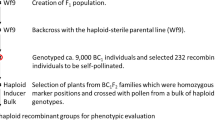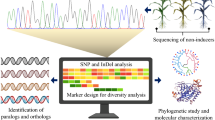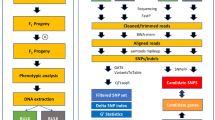Abstract
Using an F1 hybrid between Lycopersicon esculentum and L. pennellii (2n = 2x = 24) and its BC1 progeny, an attempt was made to cytologically differentiate the genomes through genomic in situ hybridisation (GISH). When total genomic DNA of L. pennellii was used as a probe with a concentration of 2 μg/μl and the stringency of hybridisation being 50% to 60%, it was possible to distinguish the chromosomes of L. pennellii from those of L. esculentum, cv Money Maker. The differentiation was observed in both somatic metaphase as well as in pollen mother cells. Whereas late prophase I and metaphase I stages were helpful to distinguish the homoeologous chromosomes, late anaphase I and telophase I stages were useful for the analysis of half-bivalents. Because the chromosome pairing and chiasma formation was completely normal in the F1 hybrid, the half-bivalents did carry recombinant chromatids but GISH procedure was not sufficient to resolve the recombinant fragments. The reason for the lack of resolution of recombination segments was assumed to be 1) the small genome size; 2)non-uniform distribution of repetitive DNA on the chromosomes in which the proximal (centromeric heterochromatin) part was fairly amenable for differentiation whereas the distal (euchromatin) part was poorly differentiated and 3) the close taxonomic relationship of the two species was another factor for the lack of clear differentiation. The first two reasons are unlikely and the third explanation was the probable explanation. In BC1progeny the chromosomes with L. pennellii centromeric regions were lower than those of Money Maker but higher than the expected mean value of 5–7. The level of differentiation between the chromosomes of the two genomes was similar as in the F1 hybrids. In view of the failure of cytological detection of homoeologous recombination, the potential of the bridging effect of L. pennellii in interspecific hybrids between potato and tomato can be better assessed through genotyping, using RFLP and AFLP analysis.
Similar content being viewed by others
References
Ali, S.N., D.J. Huigen, M.S. Ramanra, E. Jacobsen & R.G.F. Visser, 2001. Genomic in situ hybridization analysis of a trigenomic hybrid involving Solanum and Lycopersicon species. Genome 44: 299–304.
Bonierbale, M., R.L. Plaisted & S.D. Tanksley, 1988. RFLP maps of potato and tomato based on a common set of clones reveal modes of chromosomal evolution. Genetics 120: 1095–1103.
Chetelat, R.T., V. Meglic, P. Cisneros, 2000. A genetic map of tomato based on BC91) Lycopersicon esculentum ?Solanum lycopersicoides reveals overall synteny but supressed recombination between these two homoeologous genomes. Genetics 154: 857–867.
Davies, A., G. Jenkins & H. Rees, 1990. The fate of multivalents during meiotic prophase in the hybrid Gibasis consobrina ?G. karwinskyana Rafin. (Commelinaceae). Genetica 82: 103–110.
De Jong, JH., A.M.A. Wolters, J.M. Kok, H. Verhaar & J. van Eden, 1993. Chromosome pairing and potential for intergeneric recombination in some hypotetraploid somatic hybrids of Lycopersicon esculentum (+) Solanum tuberosum. Genome 36: 1032–1041.
D'Hont, A., P.S. Rao, P. Feldmann, L. Grivet, N.I. Faridi, P. Taylor & J.C. Glaszmann, 1995. Identification and characterisation of sugarcane intergeneric hybrids, Saccharum officinarum ?Erianthus arundinaceus, with molecular markers and DNA in situ hybridisation. Theor Appl Genet 91: 320–326.
D'Hont, A., L. Grivet, P. Feldmann, S. Rao, N. Berding & J.C. Glaszmann, 1996. Characterisation of the double genome structure of modern sugarcane cultivars (Saccharum spp.) by molecular cytogenetics. Mol Gen Genet 250: 405–413.
D'Hont A, A. Paget-Goy, J. Escoute & F. Carreel, 2000. The interspecific genome structure of cultivated banana, Musa spp. Revealed by genomic DNA in situ hybridisation. Theor Appl Genet 100: 177–183.
Ganal, MW., N.L.V. Lapitan & S.D. Tanksley, 1988. A molecular and cytogenetic survey of major repeated DNA sequences in tomato (Lycopersicon esculentum). Mol Gen Genet 213: 262–268.
Garriga-Calderé, F., D.J. Huigen, F. Filotico, E. Jacobsen & M.S. Ramanna, 1997. Identification of alien chromosomes through GISH and RFLP analysis and the potential for establishing potato lines with monosomic addition tomato chromosomes. Genome 40: 666–673.
Garriga-Calderé, F., D.J. Huigen, E. Jacobsen & M.S. Ramanna, 1999. Prospects for introgressing tomato chromosomes into the potato genome: an assessment through GISH analysis. Genome 42: 282–288.
Gebhardt, C., E. Ritter, A. Barone, T. Debener, B. Walkemeier, U. Schachtschabel, H. Kaufmann, R.D. Thompson, M.W. Bonierbale, M.W. Ganal, S.D. Tanksley & F. Salamini, 1991. RFLP maps of potato and their alignment with the homoeologous tomato genome. Theor Appl Genet 83: 49–57.
Jacobsen, E., P. Reinhout, J.E.M. Bergervoet, J. de Looff, P.E. Abidin, D.J. Huigen & M.S. Ramanna, 1992. Isolation and characterisation of potato-tomato somatic hybrids using an amylosefree potato mutant as parental genotype. Theor Appl Genet 85: 159–164.
Jacobsen, E., J.H. de Jong, S.A. Kamstra, P.M.M.M. van den Berg & M.S. Ramanna, 1995. Genomic in situ hybridisation (GISH) and RFLP analysis for the identification of alien chromosomes in the back cross progeny of potato (+) tomato fusion hybrids. Heredity 74: 250–257.
Jiang, J. & B.S. Gill, 1994. Nonisotopic in situ hybridisation and plant genome mapping: first 10 years. Genome 37: 717–725.
Kenton, A., 1991. Heterochromatin accumulation, disposition and diversity in Gibasis karwinskyana (Commelinaceae). Chromosoma 100: 467–478.
Khush, G.S. & C.M. Rick, 1963. Meiosis of hybrids between Lycopersicon esculentum and Solanum pennellii. Genetica 33: 167–183.
Khush, G.S. & C.M. Rick, 1968. Cytogenetic analysis of the tomato genome by means of induced deficiencies. Chromosoma 23: 452–484.
Kuipers, G.J., D.P.M. van Os, J.H. de Jong & M.S. Ramanna, 1997. Molecular cytogenetics of Alstromeria identification of parental genomes in interspecific hybrids and characterisation of repetitive DNA families in constitutive heterochromatin. Chromosome Res 5: 31–39.
Parokonny, A.S., A.Y. Kenton, L. Meredith, S.J. Owens & M.D. Bennett, 1992. Genomic divergence of allopatric siblings species studied by molecular cytogenetics of their F1 hybrids. The Plant Journal 2: 695–704.
Parokonny, A.S., J.A. Marshall, M.D. Bennett, E.C. Cocking, M.R. Davey & J.B. Power, 1997. Homoeologous pairing and recombination in backcross derivatives of tomato somatic hybrids [Lycopersicon esculentum (+) L. peruvianum]. Theor Appl Genet 94: 713–723.
Peterson, D.G., H.J. Price, J.S. Johnston & S.M. Stack, 1996. DNA content of heterochromatin and euchromatin in tomato (Lycopersicon esculentum) pachytene chromosomes. Genome 39: 77–82.
Ramanna, M.S. & R. Prakken, 1967. Structure of and homology between pachytene and somatic metaphase chromosomes of tomato. Genetica 38: 115–133.
Ramanna, M.S. & M. Wagenvoort, 1976. Identification of the trisomics series in diploid Solanum tuberosum L., group tuberosum I. Chromosome identification. Euphytica 30: 15–31.
Schwarzacher, T. & P. Heslop-Harrison, 2000. Practical in situ hybridization. BIOS Scientific Publishers Ltd. Bath. UK.
Stack, S.M., 1984. Heterochromatin, the synapotonemal complex and crossing over. J Cell Sci 71: 159–176.
Wilkinson, M.J., S.T. Bennett, S.A. Clulow, J. Allainguillaume, K. Harding & M.D. Bennett, 1995. Evidence for somatic translocation during potato dihaploid induction. Heredity 74: 146–151.
Zhong, X.B., J.H. de Jong & P. Zabel, 1996. Preparation of tomato meiotic pachytene and mitotic metaphase chromosomes suitable for fluorescence in situ hybridization (FISH). Chromosome Res 4: 24–28.
Zhong, XB., P.F. Fransz, E.J. van Wennekes, M.S. Ramanna, A.B. van Kammen, P. Zabel, J.H. de Jong, 1998. FISH studies reveal the molecular and chromosomal organisation of individual telomere domains in tomato. The Plant J 13: 507–517.
Author information
Authors and Affiliations
Rights and permissions
About this article
Cite this article
Haider Ali, S., Ramanna, M., Jacobsen, E. et al. Genome differentiation between Lycopersicon esculentum and L. pennellii as revealed by genomic in situ hybridization. Euphytica 127, 227–234 (2002). https://doi.org/10.1023/A:1020282311843
Issue Date:
DOI: https://doi.org/10.1023/A:1020282311843




